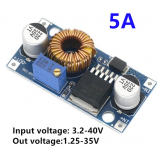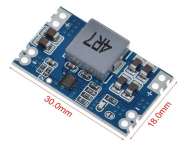My goal is to fly
Tello powered by a cable.
So I modified the original battery so that it can be powered by an external power source.
And I succeeded in connecting to WiFi while supplying power from an external power supply.
However, I tried to take off using the application for
Tello,
Tello did not take off.
Specifically, immediately after taking off from the app, the propellers rotate for a few seconds, and
Tello's power is turned off.
What could be the cause of this and any advice on how to resolve this?
Also, is there a way to fly
Tello while powered by an external power s
My goal is to fly
Tello powered by a cable.
So I modified the original battery so that it can be powered by an external power source.
And I succeeded in connecting to WiFi while supplying power from an external power supply.
However, I tried to take off using the application for
Tello,
Tello did not take off.
Specifically, immediately after taking off from the app, the propellers rotate for a few seconds, and
Tello's power is turned off.
What could be the cause of this and any advice on how to resolve this?
Also, is there a way to fly
Tello while powered by an external power supply?
probably written in the software not to take off when it thinks it's charging.
The rotation of propellers you witnessed might be signaling software work in progress???
rewriting code could solve this obviously.
Tello is an educational and open source for that very purpose, so you could fix that encode writing. look up
TELLO EDU and
Tello Robo master
before doing this, be aware that the
Tello only weighs 80 g and I have done extensive experiments to see how much lighting I could add to many tellos in order to be able to navigate steadily in the dark.
strong motors for such a small drone but your problem is going to be in finding a cord that it can lift. What micro USB cable do you have in mind? And how long/how high do you expect
Tello to be able to fly while connected, lifting the extra weight ?"from how long the chord is"?
you will need to modify a cable or strip it down to decrease weight, and even then, that will be challenging.
if you succeed at finding one light weight enough,....
you will have to navigate the cord to keep it below the propellers when descending, to keep it from tangle in propellers.
This however is most definitely worth working on.
just imagine the usefulness of such a set up?
emergency responders and militaries have corded drones that attache to automobiles that carry them.
for you to be able to make that on a much smaller micro, scale, would be impressive in its own right.
you'll still need more than one
tello as motors will burn up at some point. keep the corded Tellos on rotation if you do succeed.
I wish you much luck
and
patience!
The weight Will need to be suspended from the center of the craft. Small rig from the charging port to the center underneath or possibly using a protective cage like in this picture enclosed. Extremely lightweight and works very very well,( also allows for rollover if landing upside down!!!)

I would love to hear how you're doing with it ,as I would be happy to give advice if you need any help.
good luck keep me posted!



